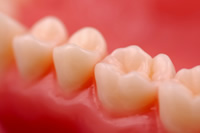Cosmetic Dentistry
Composite Bonding
 Dental bonding is a special filling that can restore, reshape and rejuvenate your teeth, improving both the function and the appearance of your smile. By applying a thin layer of tooth-colored plastic to the front of the tooth and sculpting it like clay, your dentist may use bonding to correct:
Dental bonding is a special filling that can restore, reshape and rejuvenate your teeth, improving both the function and the appearance of your smile. By applying a thin layer of tooth-colored plastic to the front of the tooth and sculpting it like clay, your dentist may use bonding to correct:
- Chipped or cracked teeth
- Broken or misshapen teeth
- Stained teeth
- Spaces between teeth
Materials for Dental Bonding
The dental bonding material is a composite resin (plastic) that hardens and fuses to the tooth when your dentist shines a special light on it. Once in place, the bonding material is shaped to correct the specific problem at hand, colored to match your natural teeth, and polished until it's smooth.
The Dental Bonding Procedure
Step One - your dentist applies an etching solution to the tooth or teeth that will be receiving the bonding material; this gently roughens the surface of the tooth for a stronger bond between the tooth and the plastic.
Step Two - your dentist places a thin layer of the bonding resin on the surface of your tooth and seals it in place using a special light. Several layers of resin may be added and hardened in turn. Each layer takes only a few minutes to harden.
Step Three - your dentist sculpts the bonding material to the desired shape and colors it to match the shade of your natural teeth. Finally, the bonding material is polished until it is entirely smooth.
The dental bonding procedure takes one to two hours. Its results last about ten years.
Types of Dental Bonding
There are two main kinds of dental bonding:
- Simple fillings like the ones described above that can be done in a single appointment
- Complex fillings that require at least two appointments and the placement of a temporary filling while the custom-shaped and -colored filling is made in a lab.
Although they take longer, custom-made porcelain fillings are more natural-looking, stain-resistant and durable than ordinary bonded fillings.
Results of Dental Bonding
Bonded teeth look and function just like your natural teeth. The dental bonding material can be colored as well as molded, so it is often possible to match the shade of your teeth. When bonding is performed by an experienced dentist, people will not be able to tell that you've had cosmetic work done on your teeth- other than seeing how good your smile looks!
Tooth-Colored Fillings
 The filling of dental cavities with unsightly metal alloys has been used throughout the history of dentistry. Contemporary fillings, however, are usually “tooth” colored and practically invisible to the untrained eye. These tooth-colored fillings can be used to replace old and worn silver amalgam, gold or other metal fillings for aesthetic purposes.
The filling of dental cavities with unsightly metal alloys has been used throughout the history of dentistry. Contemporary fillings, however, are usually “tooth” colored and practically invisible to the untrained eye. These tooth-colored fillings can be used to replace old and worn silver amalgam, gold or other metal fillings for aesthetic purposes.
These new substances have a white hue and can be made from several different origins such as composite resin, glass ionomer cement (GIC), and porcelain ceramics. These materials are very resilient and long lasting in addition to their visual advantages, but can become discolored over time. Just like metal fillings, these can be set and cured within one visit to the dentist, although they may take a little bit longer.
Tooth-colored fillings are priced similar to metallic alloys; they tend to be cheaper than precious metals but more expensive than common metals.
For more information about Cosmetic Dentistry or to schedule an appointment, feel free to fill out our convenient contact form or call us directly at 212-935-9300.

